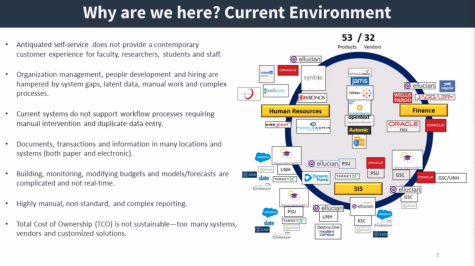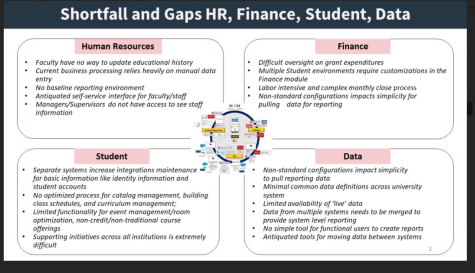USNH Set to Transition to Enterprise Research Plan
April 7, 2023
After 30 years of using antiquated software, the University System of New Hampshire (USNH) is pivoting their business systems to a new software model, called an Enterprise Research Plan (ERP). The old software encompassed all online systems associated with USNH such as Kronos, Degreeworks, Webcat, Canvas and others.
The human resources and financial components of the new system are set to be implemented this April. The student systems will launch at the end of 2027.
Discussions of updating the system began as early as 2020 when USNH filed a request for information about shifting to an ERP. Timing was complicated by the COVID-19 pandemic and work began in 2021.
“It’s laborious, inefficient and our students systems across the university system… can’t talk to one another,” said Catherine Provencher, chief administrative officer and vice chancellor for financial affairs and treasurer of USNH.
According to Provencher, none of the student and financial systems are in the cloud. This information currently exists solely on premise.

Bill Poirier, chief information officer of USNH, says that the shift may be difficult for faculty that have gotten used to the current system, but it will be overall beneficial to students and staff.
“Time is the resource you value the most,” said Poirier. “We’re trying to put together a capability that helps not just our students and being able to do all those functions, but as well to be able to do that for all our staff and faculty because their time is valuable.”
The current enterprise technology of USNH is 30 years old. As it stands, the digital environment encompasses 53 individual products provided by 32 vendors. The process of untangling these interconnected systems is intensive, but with a primary goal of providing a positive user experience for faculty, staff and students. This is part of the reason why the switch will be such a slow process.
“It was a very thoughtful and deliberate process,” said Poirier.
“You always want to start with the HR and finance systems because that’s the people in the money,” said Poirier. “When you bring in where all the revenue gets moved around… all of those things are all fully integrated. We’ve got all of these other things that are already locked in and tied together. So that’s why we picked the order that we did.”
The process of implementation has been years in the making.
“If you can imagine we put this proposal out in the first week in September, and we’re still finalizing it. And we’ve got folks running full tilt, you know, all during the day, every day and into the weekends to get ourselves to hit all our deadlines,” Poirer continued.
With emphasis on ease of future maintenance, the ability to collect and analyze data for informed decision making, and elimination of redundancies, this undertaking is a necessary one.
Poirier emphasized the importance of the ERP implementation.
“It’s a heart and brain transplant at the same time,” said Poirier.





















